The 4-Minute Rule for Hilton Head Landscapes
The 4-Minute Rule for Hilton Head Landscapes
Blog Article
Not known Factual Statements About Hilton Head Landscapes
Table of ContentsGetting My Hilton Head Landscapes To WorkExamine This Report about Hilton Head LandscapesThe Facts About Hilton Head Landscapes RevealedThe Ultimate Guide To Hilton Head LandscapesSome Known Details About Hilton Head Landscapes An Unbiased View of Hilton Head LandscapesThe smart Trick of Hilton Head Landscapes That Nobody is Talking AboutThe Ultimate Guide To Hilton Head Landscapes
Form compatibility is also a major part of unity in designone or 2 noticeably various kinds benefit comparison and focus, but usually all various other types should have some similarities for a linked look. Appearance describes exactly how crude or great the surface of the plant or hardscape material really feels and/or looks.Examples of plants with rugged texture consist of philodendrons, agaves, bromeliads, hollies, palms, and hydrangeas. Qualities that create great structure consist of tiny foliage; slim, strappy leaves (yards) or tall, slim stems; small, thick branches and tiny branches; long stems (vines); and tiny, fragile flowers.
Examine This Report on Hilton Head Landscapes
The majority of plants are average appearance, because they can not be described as having either crude or fine appearance. They are characterized by medium-sized fallen leaves with simple shapes and smooth edges. The average-sized branches are not densely spaced neither extensively spaced, and the total type is typically rounded or mounding. Medium-textured plants work as a history to link and merge the rugged- and fine-textured plants.

To make a space feel smaller sized, position the crude textures along the outer boundary and the fine structures closest to the visitor. The detail of the coarse texture makes the plants appear closer and makes the area really feel smaller sized. The viewed texture of plants can additionally transform with the distance from the plant.
The smart Trick of Hilton Head Landscapes That Nobody is Discussing
Bold colors boost the contrast and make the structure appear coarser, while low-key shades can flatten structure. Hardscape with a rugged texturesuch as extremely harsh rocks and strong, big timberstends to make all plant material appear much more medium textured. Developers often establish a structure study (Figure 8) on paper to help decide the setup of plant materials.
Color in plant material and hardscape adds rate of interest and selection to the landscape. Color is the most conspicuous element in the landscape and is generally the emphasis of a lot of property owners; nonetheless, it is likewise the most temporary element, generally lasting just a few weeks a year for specific plants.
6 Simple Techniques For Hilton Head Landscapes
A straightforward description of the color wheel includes the 3 primaries of red, blue, and yellow; the three secondary colors (a mix of 2 primaries) of environment-friendly, orange, and violet; and six tertiary shades (a mix of one surrounding key and secondary shade), such as red-orange. check my site Shade concept clarifies the partnership of colors to every various other and exactly how they need to be used in a composition.

Comparable (in some cases called harmonious) color pattern are any kind of three to five shades that are adjacent on the color wheel, such as red, red-orange, orange, yellow-orange, and yellow, or blue, blue-violet, and violet (Landscapers near me). The shades relate per various other because they usually consist of 2 primaries mixed to create an additional and 2 tertiary shades, which indicates they share typical residential or commercial properties
Complementary colors are frequently found naturally in flowers; a common pair is yellow and violet. Shade is located in the blossoms, foliage, bark, and fruit of plants.
Hilton Head Landscapes - The Facts
Environment-friendly foliage in all its different shades is the dominant color by quantity, yet other shades catch interest more conveniently as a result of their high comparison to the color green. Color is additionally discovered in structures, rocks, pavers, timber, and furnishings. Most shades in natural materials, such as stone and wood, are typically low-key and have a tendency to be variants of brown, tan, and light yellow.
Shade is a vital aspect for developing interest and variety in the landscape. Colors have residential or commercial properties that can impact feelings, spatial understanding, light top quality, balance, and focus. One building of color is explained about temperaturecolors seem cool or warm and can impact feelings or sensations. Cool colors have a tendency to be soothing and must be made use of in locations for leisure and serenity.
Hilton Head Landscapes Fundamentals Explained
The "temperature" of colors can additionally impact the perception of range. Amazing colors often tend to decline and are perceived as being farther away, making a room feel bigger. Warm colors often tend to advance and are regarded as being closer, making a space feel smaller. Color can also be utilized to capture attention and straight views.
For instance, intense yellow, which has the highest strength, also has a high comparison with all other colors (frequently defined as a "pop" of color) and should be utilized moderately. A small quantity of extreme color has as much visual weight as a huge quantity of a more controlled or weaker shade.
Similar (often called harmonious) color pattern are any 3 to 5 shades that are surrounding on the shade wheel, such as red, red-orange, orange, yellow-orange, and yellow, or blue, blue-violet, and violet. The colors relate per other since they commonly consist of 2 key colors mixed to form a secondary and 2 tertiary colors, which indicates they share usual residential properties.
What Does Hilton Head Landscapes Mean?
Complementary shades are usually discovered naturally in blossoms; a typical set is yellow and violet. Shade is found in the flowers, foliage, bark, and fruit of plants.
Environment-friendly foliage in all its different tones is the dominant color by amount, yet other shades catch attention a lot more easily as a result of their high contrast to the color green - Landscapers near me - https://www.gaiaonline.com/profiles/h1tnhdlndscps/46738857/. Shade is also found in buildings, rocks, pavers, wood, and furnishings. Most colors in natural materials, such as rock and wood, are typically muted and have a tendency to be variants of brown, tan, and light yellow
What Does Hilton Head Landscapes Mean?
Color is a crucial aspect for developing passion and range in the landscape. Shades have residential properties that can affect feelings, spatial perception, light top quality, equilibrium, and emphasis. One property of color is described family member to temperaturecolors seem cool or warm and can impact feelings or feelings. Awesome shades have a tendency to be calming and should be utilized in locations for relaxation and peacefulness.
Trendy shades have a tendency to recede and are perceived as being further away, making an area really feel bigger. Shade can additionally be made use of to capture attention and direct views - https://giphy.com/channel/h1tnhdlndscps.
As an example, intense yellow, which has the highest strength, likewise has a high comparison with all various other colors (frequently referred to as a "pop" of shade) and must be utilized moderately. A percentage of intense shade has as much visual weight as a big quantity of a much more restrained or weaker shade.
Report this page